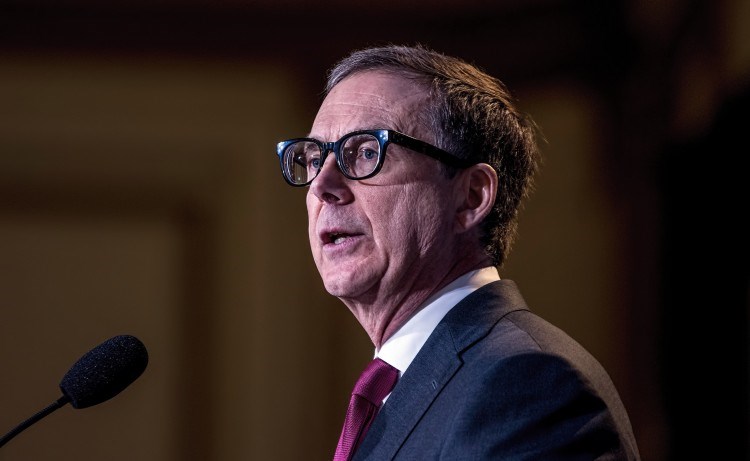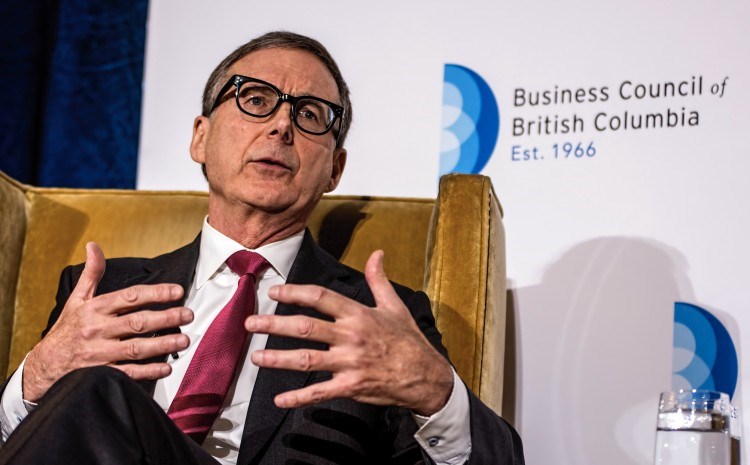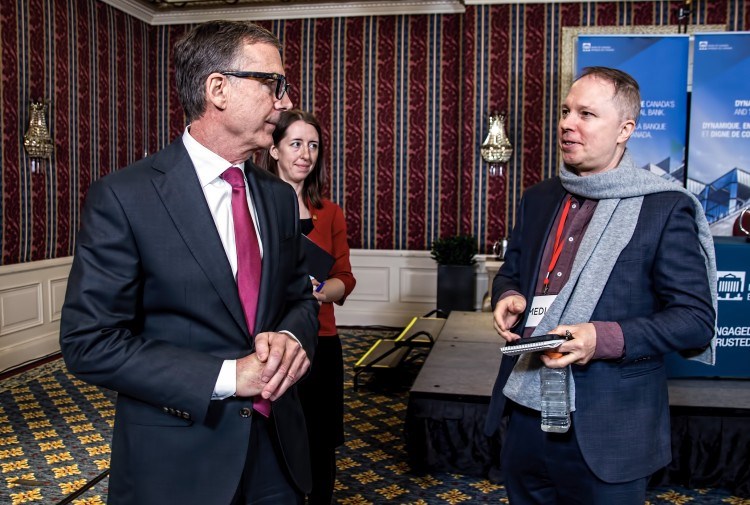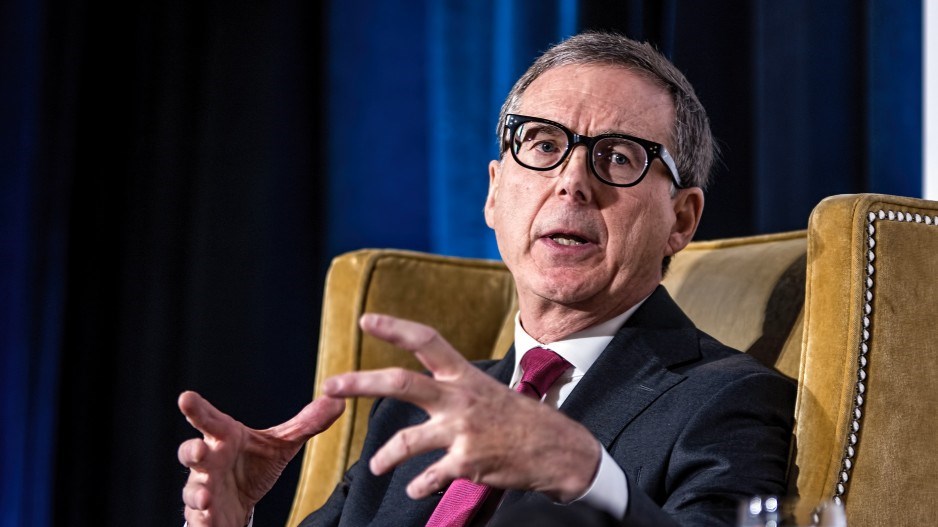Bank of Canada governor Tiff Macklem's attempts to wrangle runaway inflation by hiking interest rates was the 2022 business story that most affected Canadians’ finances.
While his may not be a household name, he played an outsized role as a kind of caped crusader, fighting the rising costs of living that all consumers endured.
Part of the reason Macklem has little public profile is because his public comments tend to be steeped in data, and economic theory. It is not his custom to provide personal anecdotes about how he is experiencing inflation or interest rate hikes.
BIV asked Macklem on Dec. 12 whether he could describe how inflation and interest-rate hikes have impacted his family.
The 61-year-old father of three responded that it had been an "intense year," before slipping into generalities about how he knows that "Canadians are feeling high inflation."
It took follow-up questions to find out that he sometimes does grocery shopping – although he said his wife, KPMG executive director Rosemary Macklem, does most of it – and that he has noticed his own grocery bills rise.
BIV asked if he pays to fill up his car with gasoline using a corporate credit card and he said that he pays for fuel himself.
The Bank of Canada's outdated website listed its governor's salary as being in 2017 up to $544,800 per year before bonuses. The bank did not respond to BIV’s request for an updated salary range.
The bank has come under fire for providing its workers $45 million in pay raises and bonuses during the pandemic – something that Macklem said he did not think was inflationary.
While Macklem's may have been a family more buffered against cost-of-living pressures than most, he has been resolute in his strategy to make life more expensive for Canadians in order to reduce inflation.
"We know that the more people understand how monetary policy works, actually, the better it works," he said.
Macklem's goal this year was to slow the economy by making mortgages and business loans more expensive, thereby reducing Canadians’ desire to take on debt while also raising costs for existing borrowers.
The risk he lived with throughout the year was that he could raise interest rates too slowly, and inflation would continue to soar, or he could go too fast, and his actions would plunge the country into recession.
On Dec. 12, he told a crowd at a Business Council of British Columbia event that the “greater risk” was to not do enough to tackle inflation.
Macklem this year watched inflation steadily rise to a 39-year peak of 8.1 per cent in June. His response, starting in March, was to raise the Bank of Canada's policy interest rate seven consecutive times, to 4.25 per cent from 0.25 per cent. The last time that this rate was higher was in early 2008.
His actions hit homeowners hard, particularly those with variable-interest-rate mortgages, as those people have been hit with mortgage costs that are four percentage points higher than at the start of the year.
"If you've got a three-bedroom property in Vancouver or North Vancouver, your minimum cost would be $1.5 million," Oakwyn Realty realtor Steve Saretsky told BIV.
"You've probably got a $1 million mortgage. Your monthly payments are probably up about $2,400 or $2,500 [compared with the start of the year.] That's a lot of money. I don't know many people who have $2,500 per month of disposable income after tax."
Almost all of those variable-rate-mortgage holders have also received calls from their lenders telling them that they have reached what bankers call their trigger rates, Saretsky said.
Most variable-interest-mortgage agreements require borrowers to pay fixed payments so payments stay flat even if interest rates rise slightly.
Instead of hiking the amounts debtors must pay after small interest-rate hikes, financial institutions steer increasing amounts of each payment toward the client's interest, and away from building home equity.
Homeowners reach their trigger rates when their entire monthly payments can no longer finance the amount of interest that they owe.
The result is that many variable-interest-mortgage holders are not only seeing huge increases in their monthly payments, but also a much smaller amount of those payments, if any, going toward building home equity.
"The rates are really starting to bite," Saretsky said. "You're going to see this filter through to the rest of the market, and businesses next year, because housing is the leading indicator."
He expects a recession in 2023.

(Image: Bank of Canada governor Tiff Macklem gave a speech at a British Columbia Chamber of Commerce event on Dec. 12 | Chung Chow)
Inflation reared its head during the pandemic
The seeds for Macklem's nemesis of inflation were planted early in the pandemic as federal government tax breaks and COVID-19 relief money provided the fiscal stimulus to make Canadians feel wealthy.
Macklem's predecessor, Stephen Poloz, provided the central bank's monetary stimulus, lowering Canadian interest rates by 50 basis points three times in March 2020 – to 0.25 per cent on March 27, 2020, after those rates started the month at 1.75 per cent.
That 0.25-per-cent rate matched the bank's lowest-ever policy interest rate, which was recorded more than a decade earlier.
Macklem took over from Poloz as Bank of Canada governor on June 3, 2020, and in July he urged consumers at a press conference to buy homes because interest rates would stay low for a long time.
The combination of fiscal and monetary stimulus led to increased consumer demand for goods, pushing up prices. Pandemic-era supply-chain disruption, in part fuelled by government lockdowns around the world, also played a role in hiking inflation by creating goods shortages that increased prices for whatever products were available for purchase.
Russia’s invasion of Ukraine similarly disrupted some supply chains, causing prices to rise.
Many economists, and even Macklem himself, now agree that he should have worked to stifle inflation earlier by hiking rates sooner this year, or late last year, and in bigger increments.
Instead, he spent much of the first half of 2022 telling people that surging inflation would be a short-term phenomenon brought on by supply-chain bottlenecks, and that it would soon resolve itself.
"The language in the Bank of Canada announcement releases was very clear about the economy operating at capacity and growth being very strong," said British Columbia Business Council senior vice-president and chief economist Ken Peacock.
"It is a bit unusual to have that strong language, and consistent language, about inflation and growth exceeding expectations but to continue to go a little bit slower on the policy-response front."
Peacock said his concern now is that the general public will start to expect that higher inflation is here to stay. That would fuel workers' demands for higher pay, and could start an inflationary spiral where employers feel compelled to pay higher wages to keep staff, and workers use their paycheques to keep demand for goods strong.
Simon Fraser University finance professor Andrey Pavlov is another economist who said he believes that Macklem should have started raising interest rates earlier.
He said Macklem tried to make up for his late start by being too exuberant in his rate increases, and by continuing them in early December, when the better course of action would have been to not raise rates again, and to simply let existing rate hikes filter through the economy.
"They have gone too far," Pavlov told BIV. "We have clear signs that the economy is slowing down."
He pointed to near-zero real gross-domestic-product (GDP) growth in September and October.
"We're basically on the verge of recession, and raising interest rates at this point, to me, puts us at risk of having a pretty significant recession."
Macklem appears to be taking this widespread criticism to heart.
“If we knew everything a year ago that we knew today, yes I think we should have started tightening interest rates sooner to withdraw the stimulus,” he told the House of Commons' Standing Committee on Finance on Nov. 23.
"We didn’t get everything right. I do think we got a lot of things right and we have some lessons to learn.”
Macklem had no apologies for running up the first quarterly loss in his central bank's 87-year history – describing the situation as "largely accounting issues."
The $522-million third-quarter loss came because his normally profitable Crown corporation provided a monetary stimulus during the pandemic that included buying more than $300 billion worth of government bonds from banks and other investors.
To pay for the bonds, it created a form of electronic money called settlement balances, which resemble deposits from commercial banks, such as the Royal Bank of Canada (TSX:RY), and held at the Bank of Canada.
Canada's central bank then pays the commercial banks interest on those settlement balances.
The combination of a huge spike in settlement balances followed by steadily rising interest rates created the situation where money owed exceeded money generated.
The result is that instead of the federal government collecting about $2.8 billion from the Bank of Canada, as it did in 2021, it will have to accommodate a financial shortfall.
The Bank of Canada has forecast continued quarterly losses until 2024 or 2025.
Pavlov said he is not too concerned about the bank's losses.
"It's not a problem, especially if we understand why," he said. "Obviously, we understand that it's because the interest rates have increased so any kind of bond portfolio has lost money."

(Image: Bank of Canada governor Tiff Macklem expands on a point during a stop in Vancouver | Chung Chow)
What's next for Macklem?
One thing Macklem has been careful to do is to give a heads-up to careful readers of his bank's interest-rate intentions.
Market watchers are known to scrutinize each syllable that Macklem utters, and that his bank includes in policy statements.
On Dec. 7, when the Bank of Canada last raised interest rates, it released a statement saying that its Governing Council "will be considering whether the policy interest rate needs to rise further."
That compares with a statement in October that said that the bank's Governing Council "expects that the policy rate will need to rise further."
The statement suggesting that the bank is now considering rather than expecting to raise rates has led some Bay Street watchers to expect either no interest-rate increase in January or a 0.25-per-cent increase, which would be bank's smallest such hike since March.
Macklem, however, is careful not to reveal his cards.
"I'm not going to speculate on what we might do in the future," he said Dec. 12 at a press conference at the Fairmont Hotel Vancouver.
"We're certainly telling Canadians how we see the economy. We're telling them what our outlook for inflation is, what the risks around that are for inflation and what we see the implications are for interest rates, but I'm going to leave any future decisions to the future."

(Image: Bank of Canada governor Tiff Macklem speaks with BIV reporter Glen Korstrom | Chung Chow)
Macklem's rate hikes largely mirrored those in the U.S.
Macklem started hiking Canadian interest rates sooner than did his counterpart, US Federal Reserve chair Jerome Powell, but the two have largely been on the same page.
Macklem on March 2 increased Canada's interest rate by 25 basis points, to 0.5 per cent, in what was the country's first interest-rate hike since 2018.
Powell then followed Macklem's lead two weeks later, with his own 25-basis-point rate hike – the U.S.'s first since 2018, to a range between 0.25 per cent and 0.5 per cent.
Canadian and U.S. interest rates historically have risen and fallen more or less in tandem.
Macklem's interest-rate hikes usually came a week or two before Powell's rate hikes.
Powell sometimes matched Macklem's interest rate hikes, and overall was more steady in his pace.
After both countries' 25-basis-point hikes in March, Macklem hiked rates by 50 basis points in April. Powell soon after, in May, did the same in the U.S.
Macklem then repeated the 50-basis-point hike in June, to 1.5 per cent, but Powell got more aggressive, hiking rates south of the border by 75 basis points, to a range up to 2.25 per cent.
Macklem caught up on lost ground in July, raising Canadian interest rates by a full 100 points, to 2.5 per cent.
Powell kept things steady by raising rates by 75 basis points for the second of four times.
Macklem then matched Powell's 75-basis-point hike in September before slowing the rate of interest-rate increases to another 50 basis points in October, and 50 basis points on Dec. 7.
Powell on December 14 started to reduce his pace of rate hikes and followed Macklem’s example by raising rates by 50 basis points, to a range between 4.25 per cent and 4.5 per cent.
Each time rates increased, homeowners with mortgages felt the pinch.




